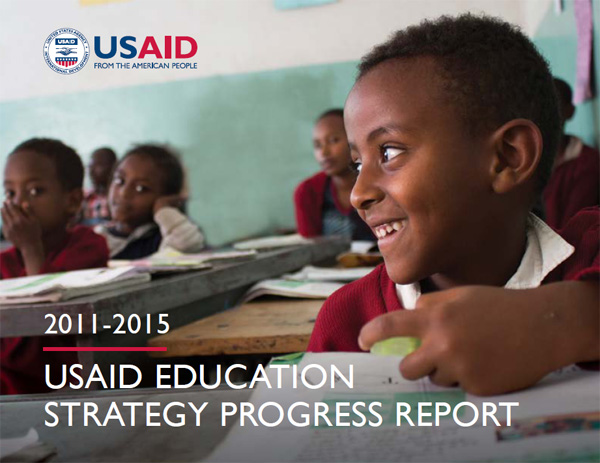Good morning everyone! I am very pleased to be here today to launch our Progress Report for USAID’s 2011 Education Strategy. Thank you all for being with us today. And, I want to especially thank you for helping to ensure that every child has the opportunity to achieve her or his dreams.
USAID Education Strategy Progress Report , 2011-2015 ![]() (pdf - 3 MB)
(pdf - 3 MB)
We are having this event today because of USAID’s commitment to report on results. It is a chance for us not only to share what we have achieved and learned, but also for us to discuss it with those who know our work best. As you will hear in more detail today, this is just the first of regular updates in the years to come on the results under this Strategy - since the Strategy is still in place and we won’t have all of the data until 2020.
Back when this Strategy was developed in 2011, the world was a decade into implementing the Millennium Development Goals (MDGs). The Education MDG was focused on getting kids into school buildings with little global attention paid to what children were actually learning inside. And, the focus was predominantly on primary education - leaving a gap in the area of workforce and higher education opportunities. And, there were still nearly 62 million children of primary age out of school, many living in conflict and crisis situations.
Also In 2011, USAID was at a key moment in its own history. For starters we were just rebuilding our policy, planning and M&E capabilities. And, the 2011 Education Strategy was the first sector strategy we issued as we rebuilt.
The Agency and U.S. Government have long prioritized education in our international development and foreign policy work. Prior to the Strategy, USAID education investments covered a wide variety of issues. Because there was little focus to our investments, we were not moving the dial in any globally important manner. And, we weren’t tracking and measuring our outcomes well which, of course, constrained our ability to continuously learn and improve.
The 2011 Education Strategy addressed this head on. We decided to focus on only three goals: early grade reading; workforce development and higher education; and education in crisis and conflict. We also committed to look at and foster new technologies and approaches which could help the world improve education outcomes. We added technical rigor to our monitoring and evaluation work. And, we committed to ensure that our work would benefit girls and boys equally.
You might be wondering why we focused on just three areas amongst all the needs in education. We chose three areas where we, many of our partner countries and those experts with whom we consulted, saw the greatest needs.
Since the Strategy was launched, we have learned how much time, work and partnership it takes to achieve significant impact. And we learned how much harder it is to achieve this focus when pivoting away from existing activities, as opposed to just starting new things.
Through our focused work, we have driven global change. For example, under the Strategy to date we have reached 41.6 million children and youth through basic education programming. Of particular importance is the fact that we have near gender parity in our programming, reaching girls and boys equally.
Beyond our direct programming, we worked significantly to set the foundation for governments to educate millions more children and youth. We championed significant policy work with Ministries of Education and Higher Education to build stronger and more equitable education systems. And, we focused everyone’s attention on measuring learning outcomes, not just measuring inputs and outputs.
As a result, in September 2015 when the United States joined other countries in committing to the Sustainable Development Goals, Goal 4 focused on quality education. It addresses what USAID has long called for: education being more than just getting children into school – instead seeking to ensure that all girls and boys have access to quality education opportunities that enable them to learn.
With that introduction, I will now turn it over to my colleague Charles North to present the report in detail. Charles has worked tirelessly on the implementation of the 2011 Strategy.
Thank you all for joining us. We look forward to discussing the progress report with you, as well as continuing to collaborate on helping all children get a quality education.
Related Speeches
- Remarks by Sean Callahan, Deputy Mission Director, USAID Cambodia, Program Launch for Early Grade Reading Support to the Ministry of Education, Youth and Sport
- Remarks by Deputy Mission Director Sean Callahan, USAID Cambodia, Don Bosco Kep Inclusive Campus Inauguration
- Wings to Fly Scholar Annual Education and Leadership Congress - Remarks by USAID/KEA Mission Director Karen Freeman








Comment
Make a general inquiry or suggest an improvement.